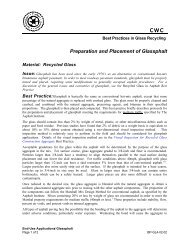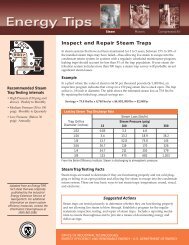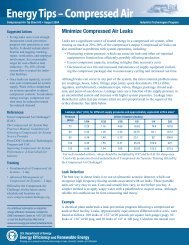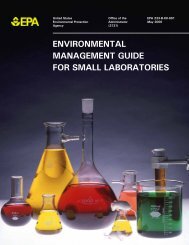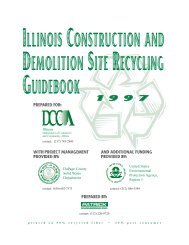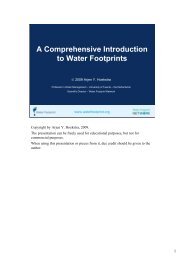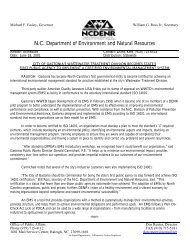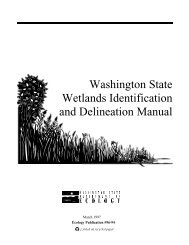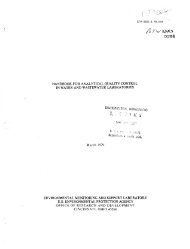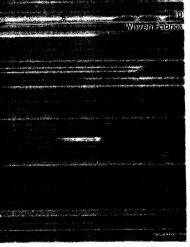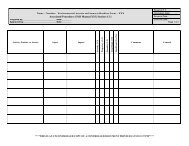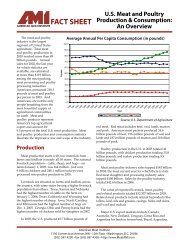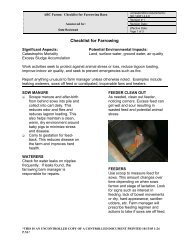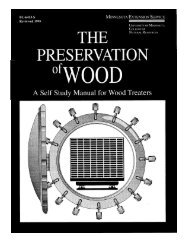Implementing Safer Alternatives to Lithographic Cleanup Solvents to ...
Implementing Safer Alternatives to Lithographic Cleanup Solvents to ...
Implementing Safer Alternatives to Lithographic Cleanup Solvents to ...
Create successful ePaper yourself
Turn your PDF publications into a flip-book with our unique Google optimized e-Paper software.
Downloaded By: [UOEH - Journal of Occupational and Environmental Hygiene] At: 20:17 10 February 2009RESULTSData CollectionOverall, 66 individuals from 15 different print shops,10 government agencies, the lithographic printing industry,and one printer’s union participated in one or moreaspects of the project. Data were gathered from: five onsiteworkplace walk-throughs involving 13 printers and/oremployer representatives; one focus group with five printersfrom three shops ranging in size from six <strong>to</strong> 35 employeesand one union representative; and 12 key informantinterviews with representatives of government agencies (N= 9), a union, the printing industry, and a printer; and a<strong>to</strong>tal of 48 workshop participants including 25 individualsrepresenting government agencies (1 federal, 4 state, and 5local agencies), 16 printers from 10 shops, five environmentalcompliance consultants, managers, or human resourcespersonnel, a union representative, and a printing industryrepresentative.Workplace ObservationsThe five print shops observed ranged in size from 6 <strong>to</strong>157 printers and had a variety of web and sheet-fed presses(Table I). Two print shops had been previous participants inthe SCAQMD technology assessment; two were recruited afterthey participated in the focus group, and one was invited <strong>to</strong>participate by the San Francisco Public Health DepartmentGreen Business Coordina<strong>to</strong>r. Printers at all of the shops cleanedthe presses’ blankets and rollers by hand either exclusivelyor as a supplement <strong>to</strong> au<strong>to</strong>mated wash systems. To clean theblankets by hand, printers applied the solvent <strong>to</strong> a wipe clothand wiped it across the blanket <strong>to</strong> remove the ink. Printershand cleaned the ink roller train by holding a squeeze bottleabove the rollers and dispensing the cleaner in a stream acrossthe length of the <strong>to</strong>p roller, and then applying pressure <strong>to</strong> therollers with a squeegee or cloth. An ink tray lined with a wipecloth was placed at the bot<strong>to</strong>m of the roller train <strong>to</strong> catch thesolvent/ink combination after it passed through the train. Usedsolvent-soaked cloths were s<strong>to</strong>red in containers with lids andsent <strong>to</strong> a commercial laundry for washing.The three print shops that provided quantitative data usedfrom 0.7 <strong>to</strong> 36 gallons of cleanup solvents daily. Printerscleaned the presses on an intermittent basis throughout theday. Each cleanup generally <strong>to</strong>ok a few minutes. At one shop, amore thorough press cleanup reportedly conducted on a weeklybasis was observed <strong>to</strong> last over an hour. Three shops estimateda printer’s direct exposure <strong>to</strong> cleanup solvents <strong>to</strong>taled fromone-half <strong>to</strong> two hours a day. Nitrile gloves were available forcleaning the press in all five shops; hand cleaning without theuse of gloves was observed at one shop. None of the print shopsroutinely used local exhaust ventilation or respira<strong>to</strong>ry or eyeprotection while handling cleanup solvents. The two smallershops (< 35 employees) also had no mechanical dilutionventilation systems.Health Impacts of Chemicals in <strong>Cleanup</strong> <strong>Solvents</strong>A <strong>to</strong>tal of 20 MSDSs for high-VOC cleanup products wereobtained as follows: 7 were provided by four of six printshops participating in the workplace walkthrough and/or focusgroup, and 13 had been obtained by IRTA from print shops thatparticipated in the SCAQMD technology assessment (Table II).The MSDSs for the 20 products included 31 hazardousingredients, and the majority of products (15 of 20) containedmore than 60% organic solvents (Table III). Thirteen cleanupproducts contained one or more chemicals with recognizedchronic health impacts beyond general solvent <strong>to</strong>xicity, includingcancer, blood abnormalities, asthmatic bronchitis, peripheralnerve damage, and reproductive/developmental effects,and 10 products contained chemicals with “skin notations”(Table II).Health Impacts of Chemicals in Alternative ProductsMSDSs for 14 alternative low-VOC cleanup productswere previously identified and evaluated in the SCAQMDtechnology assessment (Table IV). The MSDSs for the 14products included 20 hazardous ingredients (Table V). Of 14alternative cleaners, 4 had no hazardous ingredients listed onthe MSDSs, 4 were formulated from fatty acid esters andsurfactants alone or in combination, and 6 from one or moreorganic solvents (Table IV).Focus GroupAll five printers shared a general recognition that use ofcleanup solvents could impact their health and a concernabout the damage that may have already accrued from theirchronic exposures. Cancer and reproductive health hazardswere specific concerns. None of the printers was aware of theexistence of safer alternatives, and all reported receiving sometraining about chemical hazards.Demonstration ProjectTwo print shops, one large and one small, had expressedinterest in converting <strong>to</strong> safer alternatives and both were invited<strong>to</strong> participate in a demonstration project conducted by IRTA’sexecutive direc<strong>to</strong>r.At the small shop, soy- and ace<strong>to</strong>ne-based alternativecleanup products were manually tested on two sheet-fedpresses. Soy Gold 2500 followed by a plain water rinse wastested as a roller wash, and Rho-Solv 7248 was tested asa blanket wash. To prevent a fire hazard, manufacturers ofau<strong>to</strong>mated blanket and roller wash systems recommend usingmaterials with a flash point of 140 ◦ Forgreater. Based on itsflash point, the soy product was suitable for au<strong>to</strong>mated systems,but the ace<strong>to</strong>ne-based product was not. Both alternativestested met the performance expectations of the printers. Twoshopwide conversion scenarios were calculated based onthe volume of blanket and roller cleanup solvents currentlypurchased and the fact that the soy but not the ace<strong>to</strong>ne productcould be used in au<strong>to</strong>mated systems. The cost analysis assumedthat converting <strong>to</strong> alternatives would require the same amoun<strong>to</strong>f product and labor as the cleanup solvents currently in use.176 Journal of Occupational and Environmental Hygiene March 2009



